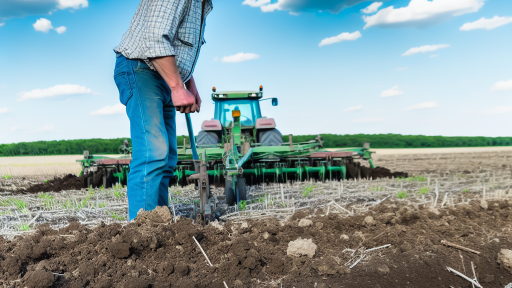Introduction to Soil Health and Its Importance in Sustainable Farming
Soil health is a vital component of sustainable farming practices.
It refers to the capacity of soil to function effectively.
Healthy soil supports plant growth, enhances biodiversity, and regulates water cycles.
Moreover, it contributes to carbon sequestration, thus mitigating climate change.
To achieve high soil health, farmers must focus on various factors.
For instance, soil structure, organic matter content, and microbial life are crucial.
Significance of Soil Health
Soil health directly affects crop yield and quality.
Healthy soil promotes root development, enabling plants to access nutrients better.
Additionally, it increases the soil’s ability to retain moisture.
Farmers benefit from improved crop resilience against pests and diseases.
This leads to reduced reliance on chemical fertilizers and pesticides.
Challenges to Soil Health
Modern farming practices often lead to soil degradation.
Over-tillage disrupts soil structure and reduces organic matter.
Monocropping depletes specific nutrients, diminishing soil fertility.
Moreover, chemical inputs can harm beneficial soil organisms.
Transform Your Agribusiness
Unlock your farm's potential with expert advice tailored to your needs. Get actionable steps that drive real results.
Get StartedThese challenges emphasize the need for sustainable farm planning.
Strategies for Enhancing Soil Health
Farmers can implement several practices to enhance soil health.
- Cover cropping prevents soil erosion and adds organic matter.
- Crop rotation improves nutrient diversity and disrupts pest cycles.
- No-till farming preserves soil structure and encourages biodiversity.
- Organic amendments, like compost, improve soil fertility.
Collaborative efforts are also essential in promoting better practices.
Farmers, researchers, and policymakers must work together.
Collectively, they can develop relevant tools and programs.
Overview of Sustainable Farm Planning
Principles of Sustainable Farm Planning
Sustainable farm planning focuses on maintaining soil health.
It promotes ecological balance and resource conservation.
This approach recognizes the interdependence of farming systems.
Furthermore, it aims to reduce chemical inputs and environmental harm.
Crop rotation is fundamental to improve soil fertility.
Diverse planting enhances resilience against pests and diseases.
Practices in Sustainable Farm Planning
Implementing cover crops enriches the soil with organic matter.
These crops prevent erosion and suppress weeds effectively.
Additionally, agroforestry integrates trees into farming systems.
It offers shade and habitats, benefiting biodiversity.
Conservation tillage reduces soil disturbance and preserves moisture.
Moreover, precision agriculture minimizes resource waste.
This technology tailors inputs to specific field areas.
Benefits of Sustainable Farm Planning
Sustainable practices lead to improved soil structure and health.
Healthy soils increase crop yields and farm profitability.
These methods also enhance water retention capabilities.
Consequently, farms become more resilient to climate challenges.
Farmers experience reduced dependency on synthetic fertilizers.
This shift supports both ecological and human health.
Showcase Your Farming Business
Publish your professional farming services profile on our blog for a one-time fee of $200 and reach a dedicated audience of farmers and agribusiness owners.
Publish Your ProfileCase Studies of Successful Implementation
Green Valley Farm practices crop rotation and cover cropping.
These strategies significantly improved their soil quality.
Likewise, Hilltop Orchards utilizes agroforestry effectively.
They found that integrating trees increased biodiversity on their land.
Both farms illustrate the transformative power of sustainable planning.
The Role of Cover Crops in Enhancing Soil Nutrients and Structure
Benefits of Cover Crops
Cover crops offer numerous advantages for soil health.
They prevent soil erosion by providing ground cover.
Additionally, they enhance soil structure and improve water infiltration.
These plants also contribute organic matter through root growth and decomposition.
Enhancing Soil Nutrients
Cover crops significantly boost soil nutrient levels.
For instance, legumes such as clover fix nitrogen in the soil.
This process improves the nutrient availability for subsequent crops.
Moreover, cover crops can absorb excess nutrients, reducing runoff.
Improving Soil Structure
Root systems of cover crops enhance soil porosity.
As roots grow, they create channels that improve air exchange.
This process helps prevent soil compaction and facilitates root growth.
Consequently, improved soil structure supports healthier crop development.
Implementing Cover Crops in Farm Planning
Farmers should select appropriate cover crops based on their goals.
Crop rotation can maximize the benefits of cover crops.
For example, pairing legumes with grasses creates a balanced nutrient strategy.
Monitoring soil health regularly ensures the effectiveness of cover crop systems.
See Related Content: Implementing IPM for Healthier Crop Yields
Implementing Crop Rotation
Enhancing Soil Biodiversity
Crop rotation increases soil biodiversity significantly.
This practice introduces various crops into the rotation cycle.
Different plants support different types of organisms.
As a result, diverse microbial communities thrive in the soil.
These organisms play essential roles in nutrient cycling.
Additionally, they help suppress pests and diseases organically.
Improving Soil Fertility
Crop rotation positively impacts soil fertility over time.
Including legumes in the rotation enhances nitrogen levels.
Legumes fix atmospheric nitrogen into the soil efficiently.
This process reduces the need for synthetic fertilizers.
Rotating deep-rooted and shallow-rooted crops promotes nutrient uptake.
Consequently, essential nutrients become available to subsequent crops.
Preventing Soil Erosion
Crop rotation plays a key role in preventing soil erosion.
Diverse root systems stabilize soil and reduce runoff.
This retention helps maintain soil structure and health.
Moreover, cover crops can be included in the rotation for added protection.
These crops shield the soil from harsh weather conditions.
Challenges and Considerations
While beneficial, crop rotation does present challenges.
Showcase Your Farming Business
Publish your professional farming services profile on our blog for a one-time fee of $200 and reach a dedicated audience of farmers and agribusiness owners.
Publish Your ProfileFarmers must carefully plan their crop selection.
This planning ensures compatibility and maximizes benefits.
Additionally, some crops may attract pests, mitigating benefits.
Continuous education on best practices remains essential for success.
Gain More Insights: Transforming Farm Waste into Valuable Resources
Incorporating Organic Matter
The Importance of Organic Matter
Organic matter enhances soil structure and fertility.
It provides essential nutrients to plants and microbes.
Moreover, it improves water retention capabilities of the soil.
This leads to more sustainable farming practices.
Utilizing Compost
Compost is a valuable addition to any farm.
It consists of decomposed organic materials like kitchen scraps and yard waste.
Adding compost enriches the soil with beneficial microorganisms.
These microorganisms feed on organic materials and promote plant growth.
The Benefits of Compost
- Enhances nutrient availability for crops.
- Reduces soil erosion through improved structure.
- Increases soil moisture retention.
- Encourages a diverse soil ecosystem.
Incorporating Manure
Manure serves as another crucial resource for soil health.
It can come from various animals, such as cows, pigs, and chickens.
When properly composted, manure is an excellent fertilizer.
It adds organic matter while also supplying nitrogen, phosphorus, and potassium.
Best Practices for Manure Application
- Test manure to determine nutrient content.
- Apply it during the growing season for maximum benefit.
- Avoid over-application to reduce runoff risk.
- Incorporate manure into the soil for enhanced nutrient absorption.
Long-Term Impacts on Soil Health
Incorporating organic matter leads to increased soil biodiversity.
A rich microbial community supports better nutrient cycling.
Healthy soil promotes vigorous plant growth and crop yields.
Ultimately, these practices enhance the sustainability of farming operations.
Uncover the Details: Conservation Tillage Basics For Beginner Farmers
Soil Testing and Assessment
Importance of Soil Testing
Soil testing serves as a foundational step in farm planning.
It helps farmers understand the specific needs of their soil.
Firstly, accurate assessments lead to improved crop yields.
Secondly, they contribute to sustainable resource management.
Methods of Soil Testing
Several methods exist for assessing soil health.
Farmers can use laboratory analysis for detailed results.
Soil sampling involves collecting soil from various locations.
This method allows for comprehensive data collection.
Laboratory Analysis
Laboratory analysis provides precise nutritional information.
It often includes testing for pH levels and nutrient balances.
Farmers then receive a report outlining necessary amendments.
This information aids in making informed decisions.
Field Sampling Techniques
Field sampling allows farmers to assess variability across their land.
Using a soil probe, they can collect samples at different depths.
Additionally, composite samples help estimate average soil health.
This strategy ensures that critical areas receive attention.
Interpreting Soil Test Results
Understanding soil test results is essential for effective planning.
Farmers should focus on macronutrients, such as nitrogen and phosphorus.
Showcase Your Farming Business
Publish your professional farming services profile on our blog for a one-time fee of $200 and reach a dedicated audience of farmers and agribusiness owners.
Publish Your ProfileMicronutrient levels are equally vital for optimal growth.
Moreover, pH levels impact nutrient availability significantly.
Guidelines for Proper Interpretation
Consulting with agricultural extension services can provide clarity.
These resources offer insights based on localized conditions.
Furthermore, tailored recommendations help maximize productivity.
Finally, keeping records of past tests can track changes over time.
Find Out More: Sustainable Farming: Crop Rotation Best Practices

The Importance of Erosion Control in Sustainable Soil Management
Understanding Erosion
Erosion is the process by which soil is worn away by natural forces.
This includes water, wind, and ice.
Human activities can significantly accelerate erosion.
Furthermore, erosion depletes essential nutrients from the soil.
Ultimately, this reduces agricultural productivity.
Impact of Erosion on Soil Health
Erosion disrupts the structure of soil.
This can lead to compaction and decreased permeability.
Healthy soils require an optimal balance of air, water, and nutrients.
When erosion occurs, this balance is upset.
Consequently, crops struggle to grow effectively.
Benefits of Erosion Control
Implementing erosion control techniques offers numerous advantages.
It helps maintain soil structure and integrity.
Additionally, healthy soils retain moisture more effectively.
This leads to improved crop yields.
Moreover, erosion control reduces the need for chemical fertilizers.
Strategies for Erosion Control
Farmers can adopt several strategies to combat erosion.
- Cover crops can help protect soil during off-seasons.
- Contour farming reduces water runoff.
- Terracing helps to slow down water flow on slopes.
- Buffer strips along waterways can filter runoff.
- Crop rotation maintains soil health and prevents erosion.
Case Studies of Successful Erosion Control
Farmers across the globe are successfully implementing erosion control methods.
In Iowa, the use of cover crops has increased soil health significantly.
In New Zealand, farmers utilize contour farming to protect hilly landscapes.
Such examples demonstrate the effectiveness of these techniques.
They also inspire others to invest in sustainable farming practices.
Community Involvement and Erosion Control
Community engagement plays a vital role in soil management efforts.
Farm workshops can educate about erosion prevention techniques.
Local governments often provide resources for soil conservation.
Collaboration can enhance the effectiveness of erosion control initiatives.
By working together, communities can achieve lasting change.
Integrating Agroforestry Practices to Improve Soil Quality
Benefits of Agroforestry
Agroforestry combines agriculture and forestry for mutual benefits.
This practice enhances biodiversity on farms.
It promotes healthier soil by increasing organic matter.
Moreover, agroforestry systems reduce soil erosion effectively.
As a result, farmers experience improved crop yields.
Types of Agroforestry Systems
Several agroforestry systems exist, each with unique benefits.
Alley cropping involves planting trees alongside crops.
Showcase Your Farming Business
Publish your professional farming services profile on our blog for a one-time fee of $200 and reach a dedicated audience of farmers and agribusiness owners.
Publish Your ProfileThis method optimizes land use while improving soil health.
Another practice, silvopasture, combines trees, crops, and livestock.
It creates a sustainable ecosystem while increasing soil fertility.
Implementing Agroforestry Practices
Farmers can implement agroforestry practices through planning.
First, assess the specific needs of the land.
Secondly, select appropriate tree species for the environment.
The chosen trees should complement existing crops.
Lastly, monitor soil health regularly to track improvements.
Challenges of Agroforestry
Despite its benefits, agroforestry presents challenges.
Initial investment costs can be high for farmers.
Additionally, knowledge and experience may be limited.
Farmers need training to implement agroforestry effectively.
Furthermore, there may be regulatory barriers to consider.
Future of Agroforestry in Soil Health
Agroforestry holds promise for sustainable farming practices.
By enhancing soil health, it promotes long-term productivity.
Support from agriculture policies can foster its adoption.
Consequently, agroforestry can play a crucial role in food security.
Integrating agroforestry is vital for healthy soils.
Long-term Benefits of Sustainable Farm Planning for Soil Health
Improved Soil Structure
Sustainable farm planning enhances soil structure significantly.
It encourages the formation of stable aggregates.
These aggregates improve water infiltration and aeration.
Healthy soil structure reduces erosion risks effectively.
Increased Nutrient Retention
Implementing sustainable practices boosts nutrient retention.
Organic matter from cover crops enriches the soil.
This process enhances microbial activity in the soil.
As a result, nutrient availability for crops increases.
Enhanced Biodiversity
Sustainable farm planning fosters biodiversity at all levels.
Diverse flora and fauna contribute to a balanced ecosystem.
Healthy ecosystems support natural pest control mechanisms.
Thus, farmers experience reduced reliance on chemical inputs.
Resilience to Climate Change
Soil health directly impacts resilience against climate change.
Improved soil structure helps retain moisture during droughts.
Additionally, biodiverse soils support resilience in extreme weather.
This resilience promotes long-term sustainability in agriculture.
Economic Sustainability
Investing in sustainable farm planning ultimately lowers costs.
Healthy soils require fewer inputs over time.
Farmers can expect increased yields from improved health.
These savings contribute to long-term economic stability.
Additional Resources
Partnerships for Climate-Smart Commodities Project Summaries …
Conservation Innovation Grants Awards Fiscal Year 2023 | Natural …
Showcase Your Farming Business
Publish your professional farming services profile on our blog for a one-time fee of $200 and reach a dedicated audience of farmers and agribusiness owners.
Publish Your Profile



